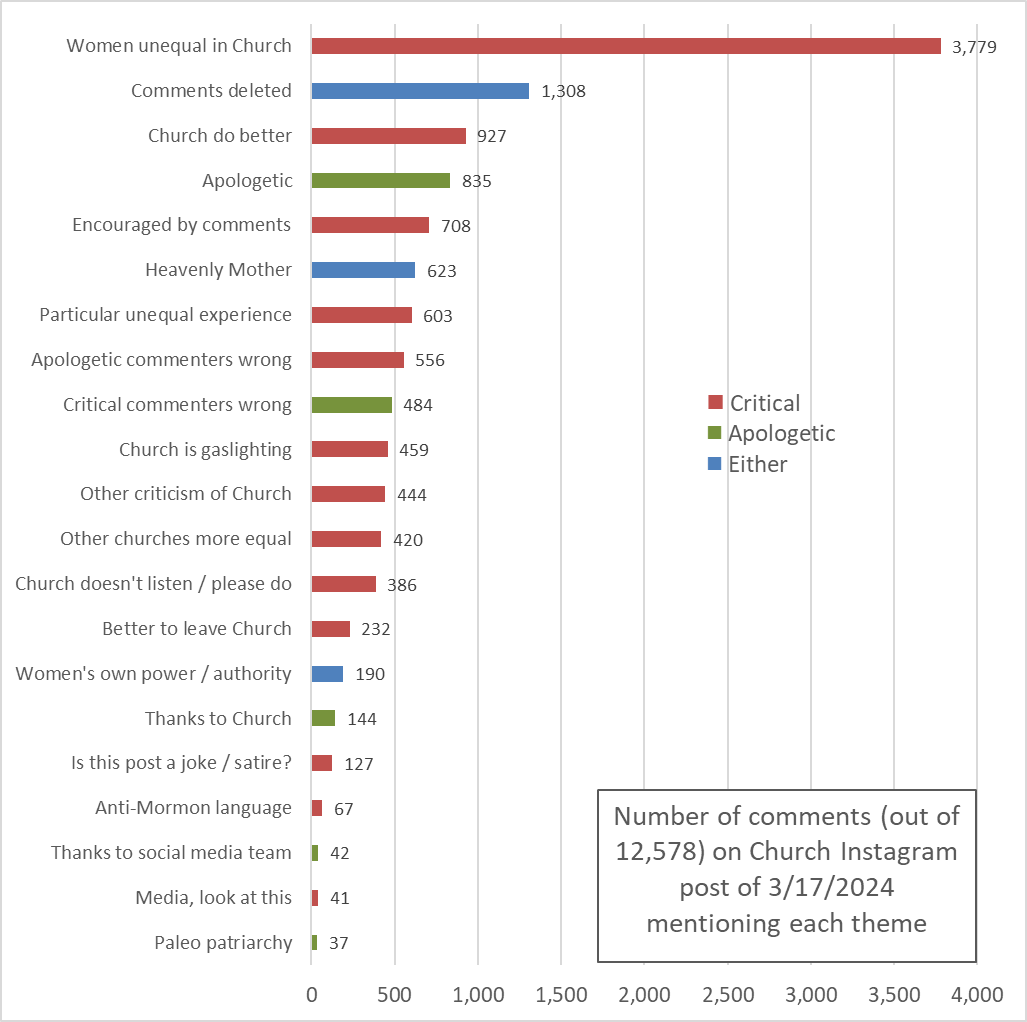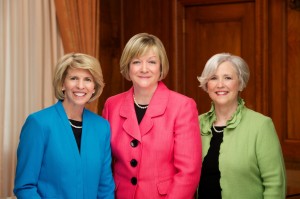A couple of weeks ago, the Church put up an Instagram post with a quote from J. Anette Dennis of the Relief Society General Presidency from her talk in the Relief Society broadcast. The quote begins, speaking of the Church:
There is no other religious organization in the world, that I know of, that has so broadly given power and authority to women.
The quote continues for a couple of paragraphs that add some context, but it has been edited since it was first put up, and I believe it was originally just this quote. In any case, it drew thousands of comments on Instagram, many from commenters saying this is obviously false. Comments were deleted a couple of days into the discussion, which provoked further outrage and sadness from commenters, but fortunately they were eventually restored and the discussion continued. The Church social media team (and many commenters) said this was a broader platform issue, although a Meta spokesperson quoted in a New York Times story (gift article—no subscription required) denied this.
The blowup was also covered in the Salt Lake Tribune. From the more apologetic side, the Deseret News published a couple of opinion pieces from women who don’t feel unequal in the Church, and Public Square Magazine put up a response to the New York Times article. From the more critical side, the Salt Lake Tribune published an opinion piece from Rosemary Card, April Young Bennett at the Exponent traced the line of thinking to then-Elder Oaks trying to placate Ordain Women a decade ago, and Lisa Torcasso Downing at Outside the Book of Mormon Belt wrote an extensive response to an apologetic post on Facebook. Molly at Roots and Reckoning also curated and categorized a few hundred of the best quotes from the Instagram discussion at her blog.
I thought it would be interesting to read all the Instagram comments. I found a handy tool called IGCommentExporter, and it pulled 12,578 comments into a csv file for me. I read through them and tagged them with themes they brought up and noted some of my favorites, and that’s what I’ll tell you about in this post.
Before I get to that, though, let me tell you about some limitations in the data and my work:
- Instagram currently says there are over 17,000 comments on the post, so when I scraped them on March 21st to start this project, I only got about 70% of them. This means that I didn’t include Sister Dennis’s follow-up comment, or any responses to it.
- At least a few people appear to have deleted their comments. I say this because in what I read, there were a lot of responses tagging commenters who appeared to have few to no comments themselves.
- The comment scraper couldn’t give me the structure of the comments, by which I mean which were replies to another commenter and which were top level. I was able to reconstruct this for about 6,000 comments by just manually loading them in my browser and using a link scraper, but for the rest, I just had to infer based on timing and who, if anyone commenters tagged.
- You can probably guess my bias, but just to be clear, I agree with April Young Bennett. I think the whole idea of women having the priesthood in some way is clearly just a hand-wavy explanation that Dallin H. Oaks came up with in an attempt to shut Ordain Women up without actually making any changes in the Church. The only way Sister Dennis’s quote can be made sense of is to start with the idea that LDS priesthood is real and all others are fake, so of course any access to it at all—even mediated through men—is better than even the best access to the fake priesthoods of other churches. (By the same logic, you could make all kinds of other absurd arguments, like that LDS churches are the most beautiful churches in the world because they’re the only real churches, and everyone else is just “playing church” [thanks, Brad Wilcox].)
- I’m sure my bias played into how I tagged themes in comments. As you’ll see, I used more granular theme tags for critical comments than apologetic ones.
- I probably should have made the theme tagging more granular in general, but at some point, reading through all the comments was a long process, and I had to stop tinkering with it and go with what I had.
- Even setting aside my biases, I probably wasn’t the most reliable tagger, meaning that if I had read through the comments more than once, I likely wouldn’t have assigned exactly the same set of tags both times. (Serious researchers do things like estimate reliability of people doing ratings by having multiple raters, but it would seem unfair to rope anyone else into reading all the comments with me.)
- I couldn’t always figure out commenters’ meaning, especially when they commented with only an emoji. For example, it was hard to distinguish laughing at from laughing with. I was fortunate that I could ask my teenage daughter the meaning of a few slang terms.
- I had hoped to do some analysis of likes of comments, but unfortunately my comment scraper didn’t gather them. I tried to sample some manually, but it was clear that Instagram was showing me commenters it thought I would like first, so my sample was inevitably going to be biased, so I had to give this up.
Is that enough caveats? Okay, here’s what I found. I read 12,578 comments. I assigned each comment at least one tag, a total of 16,921 tags, or about 1.3 per comment. This graph shows how often the tags were used.

